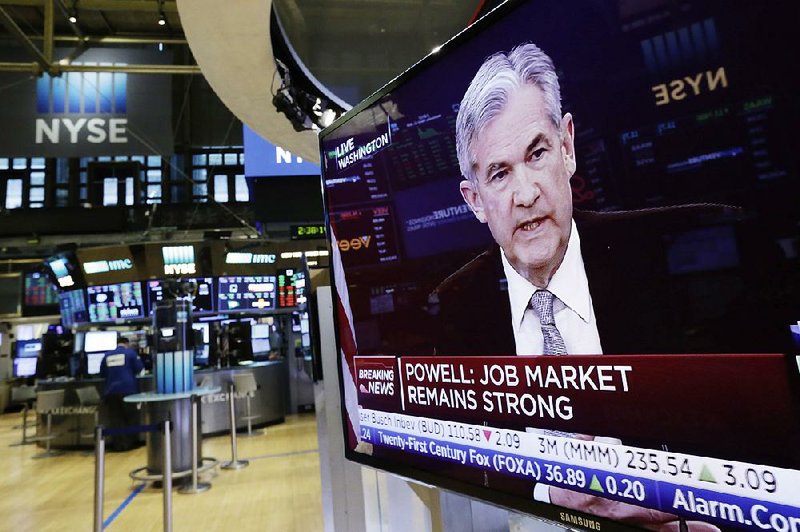The Federal Reserve raised interest rates Wednesday by a quarter of a percentage point and signaled that the central bank is on track to raise rates twice more in 2018.
The Fed raised its benchmark interest rate to a range of 1.5 percent to 1.75 percent, marking the sixth time since the financial crisis that it has raised rates.
The Fed said at the conclusion of a two-day policy meeting that the economy continues to strengthen and that it expects to increase rates another two times this year as it pursues a return to more normal interest-rate levels. Officials also increased their expectations for economic growth this year in the United States, declaring that "the economic outlook has strengthened in recent months." They said they expect to raise interest rates three times next year, an increase from the two increases in 2019 that they forecast in December.
Rising interest rates are typically good for savers, who are likely to receive higher interest on the savings they have in the bank. Borrowers, however, face higher costs when they go to get a mortgage, auto loan or small-business loan. Americans with credit-card debt are especially vulnerable to rising interest rates. The average credit-card rate is already a full percentage point higher than it was a year ago and is likely to jump more this year as the Fed increases rates further.
Jerome Powell, the new Fed chairman, expressed optimism about the current economic picture and said officials were trying to strike a balance between raising rates too slowly or too quickly. "We're trying to take that middle ground," he said in a news conference after his first policy meeting as head of the central bank. Powell, a former Fed governor, succeeded Janet Yellen last month.
The Fed, under Yellen, pursued gradual rate increases and a highly choreographed sell-off of the portfolio of bonds it bought to help prop up the economy after the 2008 financial crisis. Powell was among the governors who voted for that approach, and the announcement Wednesday signaled that he will maintain it, particularly if economic growth continues to accelerate and unemployment remains at or below the 4.1 percent level it reached in February.
The announcement underscores the Fed's gathering confidence in the economy as well as its focus on the potential for inflation, which has remained persistently muted throughout the expansion. Officials raised their median estimates for economic growth this year to 2.7 percent, up from 2.5 percent in December. They raised their estimate for growth in 2019 to 2.4 percent, up from 2.1 percent. They now expect the unemployment rate to fall to 3.8 percent this year and 3.6 percent in 2019, a low level by historical standards. In December, officials said they expected unemployment to be 3.9 percent this year and next.
Officials' growing optimism tracks with the expectations of many Wall Street analysts. "We think Fed officials will view the growth and inflation data in recent months as encouraging," analysts at Goldman Sachs wrote in a research note before the meeting, "particularly with tax cuts now implemented and with an additional fiscal boost from federal spending arriving this year."
In his news conference, Powell left the door open to more or fewer than three increases this year, depending on economic conditions. "Like any set of forecasts, those forecasts will change over time," he said. "It could change up. It could change down"
Some analysts say a short-term economic stimulus from Congress -- in the form of a $1.5 trillion tax cut and federal spending increases -- could eventually push the Fed to add a fourth rate move.
A portion of the voting membership of the committee rotates every year among the Fed's regional bank presidents. The new members tend to worry more about inflation than those they replaced. Even some members who have fretted more about growth than inflation appear to be shifting their calculus.
Lael Brainard, a Fed governor who has been less hawkish than many of her colleagues, said in a speech this month that in many ways, "today is the mirror image of the environment we confronted a couple of years ago."
"In the earlier period, strong head winds sapped the momentum of the recovery and weighed down the path of policy," she added. "Today, with head winds shifting to tail winds, the reverse could hold true."
Fed officials signaled in several ways that they see the economy strengthening. Along with raising their growth forecasts, they declared in a statement that "economic activity has been rising at a moderate rate" and that "job gains have been strong in recent months." In January, officials described economic activity and job growth as "solid."
The statement also declared, in a change from January, that "the economic outlook has strengthened in recent months." It said officials expect the inflation rate to move up "in coming months." In January, officials said they expected inflation to increase this year.
That increased optimism appears to downplay lingering uncertainties in the recovery, including structural issues such as a ballooning debt load and trade barriers that could turn the economy's tail winds back into head winds. Recent data suggest that economic growth is falling short of expectations for the first quarter. Wage growth appears to be improving, but the signs are mixed. Markets have been rattled in recent weeks by Trump's tariff plans and embrace of a potential trade war.
Information for this article was contributed by The Washington Post.
Business on 03/22/2018
